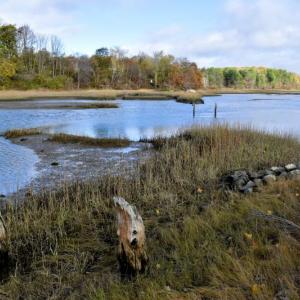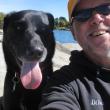Wiscasset’s Cow Island: Where’s that?
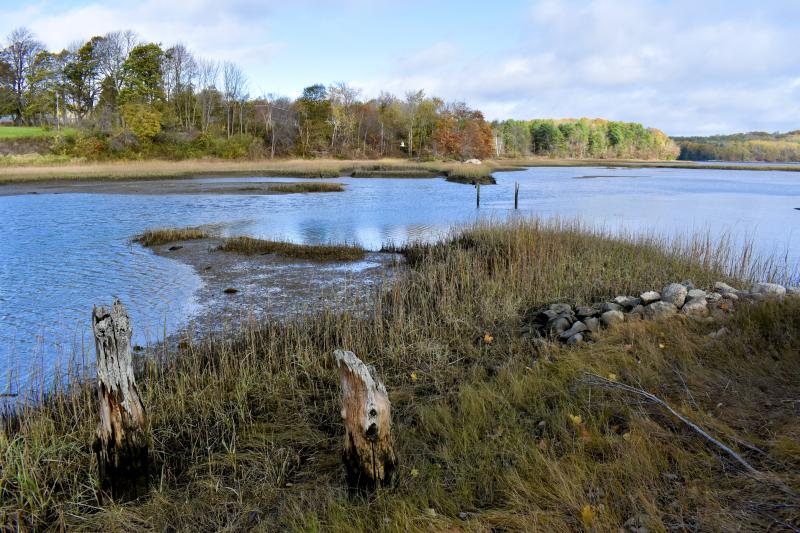 Looking toward Federal Street from the western shore of Cow Island. The piling shows the path of the former narrow gauge railroad. PHIL DI VECE/Wiscasset Newspaper
Looking toward Federal Street from the western shore of Cow Island. The piling shows the path of the former narrow gauge railroad. PHIL DI VECE/Wiscasset Newspaper
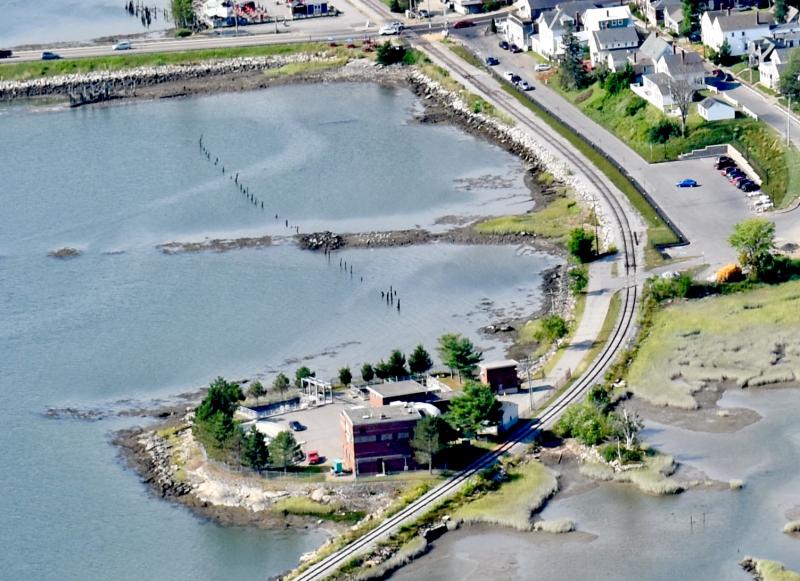 Cow Island as it now looks showing Wiscasset’s sewer treatment plant, railroad tracks and causeway. The rows of piling in the river show the path of the former Wiscasset, Waterville and Farmington Railroad, a narrow gauge railway that operated from 1895 until 1933. At the top, U.S. Route 1 leads motorists over Donald E. Davey Bridge and, at the right, is Railroad Avenue where the former train station was until it was moved to North Edgecomb in the 1980s. PHIL DI VECE/Wiscasset Newspaper
Cow Island as it now looks showing Wiscasset’s sewer treatment plant, railroad tracks and causeway. The rows of piling in the river show the path of the former Wiscasset, Waterville and Farmington Railroad, a narrow gauge railway that operated from 1895 until 1933. At the top, U.S. Route 1 leads motorists over Donald E. Davey Bridge and, at the right, is Railroad Avenue where the former train station was until it was moved to North Edgecomb in the 1980s. PHIL DI VECE/Wiscasset Newspaper
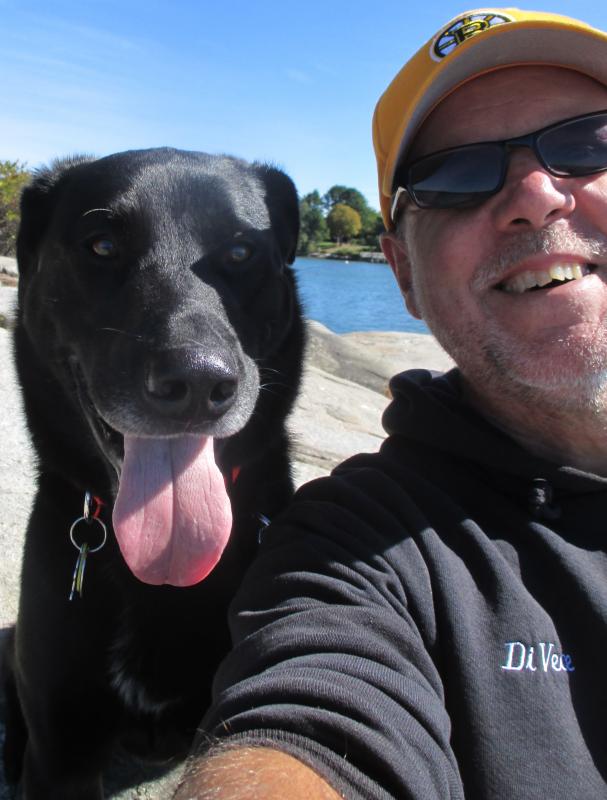
 Looking toward Federal Street from the western shore of Cow Island. The piling shows the path of the former narrow gauge railroad. PHIL DI VECE/Wiscasset Newspaper
Looking toward Federal Street from the western shore of Cow Island. The piling shows the path of the former narrow gauge railroad. PHIL DI VECE/Wiscasset Newspaper
 Cow Island as it now looks showing Wiscasset’s sewer treatment plant, railroad tracks and causeway. The rows of piling in the river show the path of the former Wiscasset, Waterville and Farmington Railroad, a narrow gauge railway that operated from 1895 until 1933. At the top, U.S. Route 1 leads motorists over Donald E. Davey Bridge and, at the right, is Railroad Avenue where the former train station was until it was moved to North Edgecomb in the 1980s. PHIL DI VECE/Wiscasset Newspaper
Cow Island as it now looks showing Wiscasset’s sewer treatment plant, railroad tracks and causeway. The rows of piling in the river show the path of the former Wiscasset, Waterville and Farmington Railroad, a narrow gauge railway that operated from 1895 until 1933. At the top, U.S. Route 1 leads motorists over Donald E. Davey Bridge and, at the right, is Railroad Avenue where the former train station was until it was moved to North Edgecomb in the 1980s. PHIL DI VECE/Wiscasset Newspaper
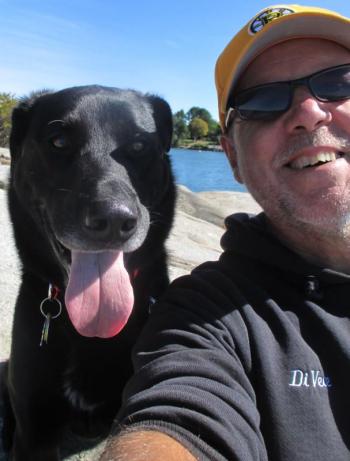
Once upon a time there was “Cow Island.” It was just north of Wiscasset village, a short walk from where the train station used to be. As the story goes, folks got to calling it Cow Island because a farmer would lead his dairy herd out to the grassy island at low water. They’d graze there until the tide turned when they’d be led back to the barn. This was long ago, way before the island became home to Wiscasset’s sewer treatment plant. Before I go any further, Cow Island isn’t an island anymore, and hasn’t been since 1870. That’s when a causeway was built to carry the Knox & Lincoln railroad tracks across the cove to Clark’s Point.
After the railroad was finished, a train station and depot were built just a short distance from Cow Island. The depot disappeared ages ago but the old wooden station painted gray was still there in the 1980s. Remember? The railroad sold the building to Dan Chase in 1983, and he had it moved across the Sheepscot River to North Edgecomb. It can be seen today serving as the office for Chase Associates located on Route 27; look for it next time you’re on the road to Boothbay.
The earliest mention I found of Cow Island comes from the former Lincoln County News, a different newspaper from the one that bears the same name today. This earlier Lincoln County News, also a weekly, was published Fridays on the corner of Main and Water streets in Waldoboro by Samuel L. Miller, single copies sold for four cents. The edition of April 22, 1881 included a report by the Wiscasset correspondent of some unsavory activities taking place on Cow Island.
“A little to the northeast of the Knox & Lincoln Railroad station is a small piece of land called ‘Cow Island.’ It can hardly be called an island, as in building the railroad a peninsula was made of it, by connecting it to the mainland,” begins the story which is unsigned. “Years ago, a circus company performed here,” it continues, “and if memory serves us right the performing ‘ring’ was in the center of the island. But until last Saturday we don’t think it was ever used as a cock pit!”
Let’s pause for a moment while I explain what a “cock pit” is. What the writer is referring to is a contest pitting a pair of roosters, aka gamecocks against each other. The birds are put in a ring or pit in this case to fight while gamblers place bets on the outcome. The gruesome contests are usually fatal for one of the birds. Laws were passed to ban cockfighting but unfortunately, this didn’t always stop them from happening. “At first we could hardly make out what could cause such a large crowd there, but after a time we could see that a cock fight was in progress, yes a genuine cock fight!” adds the writer who was clearly shocked this was happening under the nose of the law and in the county seat no less. “We are informed that this activity has been going on in the vicinity of the depot for some time and that small boys are witnesses of this outrageous spectacle.” The author concludes no “respectable citizens” are associated with the “disgraceful affair” and parents concerned about the “moral welfare of their children” should take appropriate action. As you might imagine the story stirred up a good deal of talk around town bringing about a swift end to the notorious cock fights.
Earlier, during the Civil War, Cow Island served as a place for artillery practice for Wiscasset’s Home Guard, that was a local militia organized by Capt. Richard Holbrook Tucker Jr. Capt. Tucker gained his title not from any military involvement, but from having been both a ship’s master and shipowner. At the start of the war in April 1861, he was in his prime, 45 years old, and serving both as chairman of the Wiscasset select board and State Senator from Lincoln County. Tucker and a few other ardent defenders of the Union organized the Home Guard for the defense of Wiscasset harbor against a possible Confederate attack. Capt. Tucker secured a pair of brass cannon, ammunition and gunpowder from the state armory. Naturally, he wanted to try out the cannon and Cow Island provided a convenient place, close enough so the townspeople could hear the boom of the guns.
Legend has it a band of wandering gypsies made yearly stops to Wiscasset setting up their camp on Cow Island. They’d circle their brightly colored wagons where they told fortunes, sold “magic” elixirs, and jewelry fashioned from copper. They were known for robbing the hen house and pantry too if they could get away with it. When the town folk grew tired of them the law was called upon and they moved along to the next town. This has me wondering whether there might have been a source of fresh water on the island, a dug well perhaps, or maybe a natural spring.
The island had a number of private owners. One of the earliest was William Groves, whose descendent is Steve Christiansen of Willow Lane, Wiscasset. In the late 18th century Groves owned a sizable tract that extended to the waterfront including Cow Island, which for a time was known as Groves Island. The island was considerably larger then and completly surrounded by water at least at high tide. That changed with construction of the K & L RR railroad. A row of rotting piling in the river shows the path of the former Wiscasset, Waterville and Farmington Railroad, a narrow gauge railway that operated from 1895 until 1933. It ran alongside the western shore of Cow Island.
Later, Cow Island became the property of Alvin Foye Sortwell, a great-great grandfather of Wiscasset’s Daniel Sortwell who lives on Churchill Street where his ancestors once ran a dairy farm. Sortwell now operates a coffee roasting business in the barn where the cows were once milked. “Between 1898 and 1910 would be my guess as to when my great-great grandfather acquired the island,” he told me adding, Alvin Sortwell moved to Wiscasset in the late 1890s. He died at age 56, rather young by today’s standards. At some point Alvin Sortwell built bath houses on Cow Island. Dan remembers his late father, Dan Sr. telling him he used to go swimming there.
In 1960 the powers that be in Wiscasset decided Cow Island was an ideal place to build a sewer treatment plant. The facility has been upgraded twice since, the most recent taking place in 1992.
Phil Di Vece earned a B.A. in journalism studies from Colorado State University and an M.A. in journalism at the University of South Florida. He is the author of three Wiscasset books and is a frequent news contributor to the Wiscasset Newspaper and Boothbay Register. He resides in Wiscasset. Contact him at pdivece@roadrunner.com

